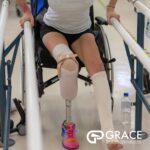Why is phantom pain usually worse at night time?
Phantom pain is a phenomenon that’s been experienced by millions of people with amputated limbs. This can be very frustrating because the source of the pain isn’t readily apparent, nor is potential treatment. One of the questions that we sometimes get asked is, “Why is phantom pain worse at night?”
While this might sound strange, it’s something that’s reported by many prosthetic patients. Today, we’re going to discuss whether or not it’s true and then provide you with several types of treatment for relieving phantom pain.
What Causes Phantom Pain?
Before we answer the question, “Why is phantom pain worse at night?”, it’s important to understand what phantom pain actually is. Basically, this is when a person feels pain from a body part that has been surgically removed. The pain is just as severe as if the body part were still there. It’s typically felt by someone who has had a lower or upper extremity amputated, though it can happen when an internal organ has been surgically removed as well.
No one’s been able to determine exactly what causes phantom pain. The leading theory, however, is that after a body part has been removed, nerves in the brain and spinal cord inadvertently get “rewired” due to a loss of signal. This causes pain signals to be sent to your brain even though there isn’t a physical body part involved anymore. This sensation typically improves over time but can be troubling for months or even years.
Why Is Phantom Pain Worse at Night?
Many patients have reported that their phantom pain is worse at night than it is during the day. Is this true, or is it something psychological? Well, it’s actually a little bit of both. The time of day really has nothing to do with the severity of phantom pain; it’s all about how much focus you’re putting on it.
Most people are active during the day, and the multiple distractions that we experience make the pain seem less severe. But, when you’re home at night and laying in bed, where you have fewer distractions, the pain will often be more noticeable because your body and brain aren’t being occupied by other things.
How Do you Relieve Phantom Pain?
When a person first starts experiencing phantom pain, it can be very distressing. After all, since there isn’t a physical body part involved, patients will often believe that they can’t do anything about it. Luckily, this is inaccurate. Here are some of the treatments that have been effective in relieving phantom pain:
- Custom Prosthetic — Doctors can’t explain exactly why wearing a prosthetic can reduce phantom pain. Most likely, it’s because your brain is basically being tricked into thinking that the amputated limb is still there.
- Anti-Inflammatory Meds — To help control pain, prosthetic patients are often provided with non-steroidal anti-inflammatory drugs. If a person is suffering from severe pain, they may be prescribed opioids.
- Nerve Stimulation — Sending electrical signals to a person’s nerves can lessen the amount of pain. Nerve stimulation devices are becoming more commonplace for prosthetic patients.
- Antidepressants — It’s also possible that phantom pain may be the result of heightened sensitivity from a disease or disorder. Antidepressants reduce this sensitivity, in addition to helping with stress that comes with the removal of a limb.
- Other Medications — Several other types of medication treatments, such as topical creams and beta blockers, can reduce phantom pain. The results vary from person to person, so it’s recommended that a patient tests out a few different ones.
- Rehabilitation Psychologist — Amputees are often referred to a rehabilitation psychologist to help them deal with stress and other problems. This type of treatment can reduce the amount of phantom pain that a person experiences.
- Mirror Therapy — As the name suggests, this treatment involves a person standing in front of the mirror so that it looks like their limb is still there. This can trick the brain into thinking the amputated limb is still intact so that it stops sending pain signals.
- Augmented Reality — This treatment uses a computer simulation to trick a person’s brain into thinking that a limb is still intact, which can result in a reduction of pain signals. It’s an upgraded version of mirror therapy and has been effective in many patients.
- Alternative Therapies — Alternative therapies such as acupuncture and acupressure have been shown to be effective in reducing phantom pain. The degree of success will depend on how well a particular patient’s body reacts to the treatment.
- Corrective Surgery — If none of the other treatments listed here are effective in relieving phantom pain, corrective surgery may be offered. This last resort measure has potential risks and rewards, which a physician will discuss with the patient.
Contact Grace for Help Relieving Phantom Pain
Grace Prosthetic Fabrication helps doctors and patients from around the world with the creation of custom prosthetics, orthotics, and supporting devices. If you have any questions similar to “Why is phantom pain worse at night?” or would like to learn more about our products, give us a call at (800) 940-5347 today.






